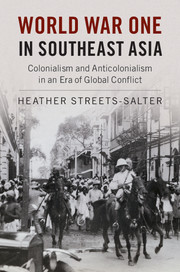Book contents
- Frontmatter
- Dedication
- Contents
- Acknowledgments
- List of Maps
- Maps
- Introduction
- 1 The Singapore Mutiny of 1915: Global Origins in a Global War
- 2 The Defeat of the Singapore Mutiny: Regional Expression of Global Alliances
- 3 Germans, Indians, and the War in the Dutch East Indies
- 4 The S.S. Maverick and the Unraveling of a Global Conspiracy
- 5 Siam and the Anti-Allied Conspiracies
- 6 China, Germany, and the Viet Nam Restoration Association
- Conclusion
- Select Bibliography
- Index
5 - Siam and the Anti-Allied Conspiracies
Published online by Cambridge University Press: 06 April 2017
- Frontmatter
- Dedication
- Contents
- Acknowledgments
- List of Maps
- Maps
- Introduction
- 1 The Singapore Mutiny of 1915: Global Origins in a Global War
- 2 The Defeat of the Singapore Mutiny: Regional Expression of Global Alliances
- 3 Germans, Indians, and the War in the Dutch East Indies
- 4 The S.S. Maverick and the Unraveling of a Global Conspiracy
- 5 Siam and the Anti-Allied Conspiracies
- 6 China, Germany, and the Viet Nam Restoration Association
- Conclusion
- Select Bibliography
- Index
Summary
Twelve days after the Singapore Mutiny, on February 27, 1915, the consul-general in Bangkok – T.H. Lyle – wrote the Foreign and Political Department in India that “there may be some intimate connection between the efforts of Indian political agitators [in Siam] and the recent outbreak of Indian troops in Singapore.” According to Lyle, a credible source indicated that a “well-educated leader of the Indian revolutionary movement” had been in Bangkok in January 1915 and had then gone to Singapore “to cause a rising among the Indian troops.” Moreover, he added, the General Advisor to the Siamese Government had recently told Lyle that Germans in Siam were anxiously anticipating a general Indian uprising that was supposed to occur in late February or early March.
Whether or not Lyle's information was accurate, its importance for our purposes is in the way it linked Indian revolutionaries in Siam not only with disturbances in Singapore but also with hostile Germans seeking to disrupt British colonial rule. As it turned out, the route between North America, the East Indies, and India discussed in Chapters 3 and 4 was only one of the paths through which Indian revolutionaries and Germans sought to smuggle arms and insurgents to India through Southeast Asia. A second route was through Siam – an independent state sandwiched between British Burma to the west, British Malaya to the south, and French Indochina to the east. Like its northern neighbor China, Siam remained neutral during the war until summer 1917. As in all neutral countries or colonies, Siamese neutrality meant that the diplomatic and business interests of both the Central Powers and the Allies continued to operate there after hostilities commenced. As a result, Siam provided – at least initially – a staging ground from which anti-Allied colonial activists and representatives of the Central Powers could operate with relative impunity.
Siam was strategically important to those who sought to undermine Allied colonial rule because of its unique geography. To its east lay Indochina, the most important French colony in Asia, while to its west lay Burma, which not only was a British colony but also allowed overland access to Britain's largest and richest colony: India.
- Type
- Chapter
- Information
- World War One in Southeast AsiaColonialism and Anticolonialism in an Era of Global Conflict, pp. 142 - 168Publisher: Cambridge University PressPrint publication year: 2017



